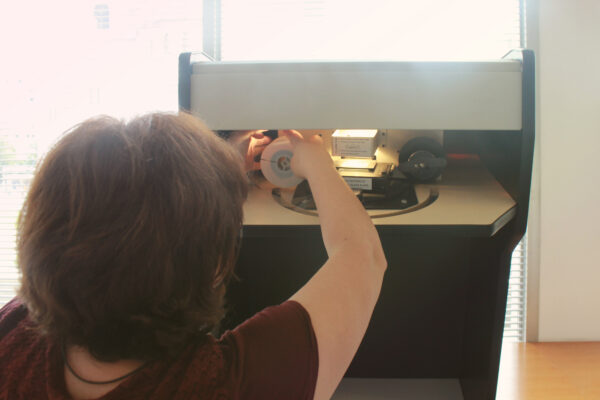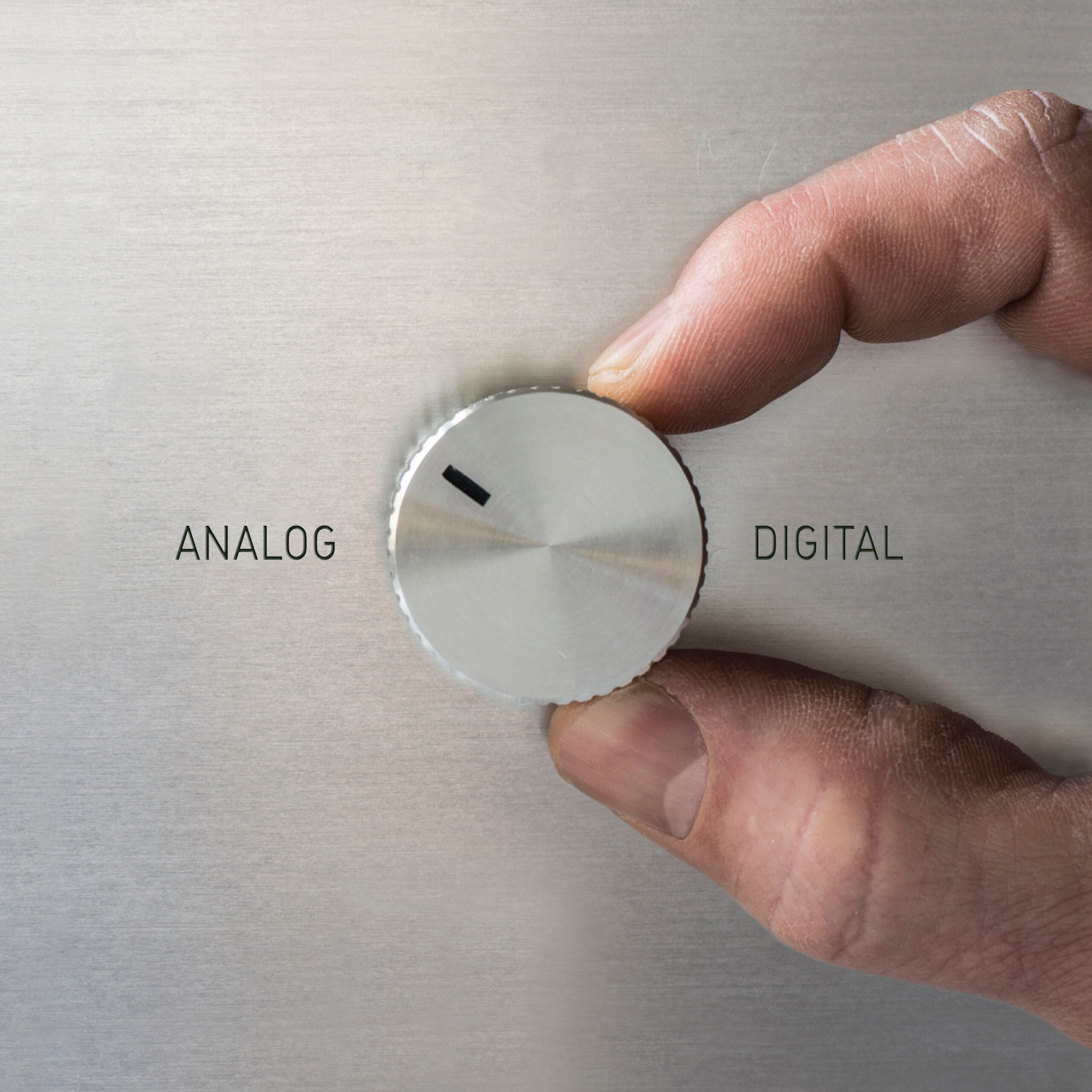You have microfilm and need to access it, but you’re not sure if you should get a microfilm reader/scanner (hardware) or have it digitized to an electronic format.
Or maybe you already have a microfilm reader, but it’s old or breaking down, and you’re debating if you should replace it.
You’ve come to the right place!
In this article we’ll describe some pros and cons to microfilm readers, go over the benefits of digitizing, and show you how to evaluate the costs of either choice.
Understanding the Pros and Cons of Microfilm Readers
Microfilm has long been a staple in record collections, necessitating the development of microfilm readers for data access. In most records management departments, a collection of microfilm reels is typically accompanied by one or more microfilm readers. This setup allows individuals who need data access to easily use the microfilm on these readers.

In public spaces like libraries, microfilm is often accessible to the public for use on physical readers. Similarly, in building departments, individuals can request microfilm from the front desk to use on available readers. This widespread availability underscores the traditional importance of microfilm machines.

Limitations of physical microfilm readers for modern-day needs
For decades, microfilm readers were an efficient method for accessing data. However, as technology advanced, digital alternatives for accessing microfilm data emerged. Despite their historical utility, microfilm readers have several limitations:
- Storage requirements for microfilm can be extensive, needing cabinets, drawers, and space.
- Typically, there’s only one copy of a microfilm. If it’s damaged or lost, the data is irretrievable.
- Public use can lead to quick wear and tear, loss, or theft of microfilm.
- The manual operation of microfilm readers can be cumbersome, especially when searching through small images on lengthy rolls.
In contrast, digitally scanning and accessing microfilm records makes using physical readers seem outdated.
Maintenance and operational considerations for hardware units
Beyond the physical limitations, microfilm readers and scanners require regular maintenance, as hardware inevitably breaks down. As these units become less common, finding skilled maintenance personnel becomes challenging. Additionally, as older units become obsolete, the need to purchase and maintain new units arises, adding to operational costs.

Benefits of Digitizing Microfilm Collections
Streamlining access and retrieval of records through digitization
Digitizing microfilm streamlines the process of accessing and retrieving records. Here’s the old process of using physical microfilm:
- going to the physical location of the microfilm
- finding the specific reel you need
- walking back to your microfilm reader/scanner
- putting the microfilm on the hardware
- scrolling through the length of the film (which can be 100’ or 215’ and thousands of images)
- finding the exact image you need
- making sure it’s prepared and optimized
- exporting the image either by print or scanning to a thumb drive or local network
That’s a lot of work!
Comparatively, digital records allow for quick and easy access. Users can simply open an application, enter the index information, and instantly access and export the needed images.
By scanning your microfilm, you cross the river from analog to digital and experience the benefits that come with digitization.

Enhanced security features with digital storage solutions
When your microfilm records are converted to a digital format, you gain the ability to significantly enhance the security surrounding these records. It’s important to note that not all data will necessitate heightened security measures. For example, if you have digitized newspaper microfilm and allow patrons to access these files, this is public information and doesn’t require extensive security.
However, for sensitive or confidential records, such as criminal records, case files, medical information, financial records, and so forth, the ability to add multiple layers of protection is crucial. With physical microfilm, the most you can typically do is secure the physical storage area, such as using locked cabinets.

In contrast, digital formats offer a range of security options. You can physically restrict access to these records, for instance, through IP address filtering and secure locking systems. Digital security methods are also available, including multi-factor authentication, permissions-based access, and single sign-on capabilities. These digital tools provide a robust framework to safeguard sensitive information, far beyond what physical storage can offer.
Long-term cost savings and reduced physical storage needs
Digitization not only significantly improves accessibility but also offers long-term cost savings by eliminating the need for physical microfilm storage. Once you have a digital copy, particularly with backups, the original microfilm becomes redundant. Often, organizations place these physical copies in long-term storage, which means they’re seldom accessed again. Some organizations may even dispose of the physical records, relying solely on their digital versions and backups.

Removing the physical microfilm collection frees valuable space for other uses within the organization, potentially leading to substantial reductions in storage costs.
Evaluating The Costs: Microfilm Readers vs. Digitization Services
Initial investment and ongoing costs of microfilm reader units
Purchasing microfilm reader or scanner units involves an initial investment, followed by ongoing maintenance costs. These costs include not just the physical repair and upkeep of the hardware but also the time and resources spent by personnel in managing and using the microfilm. This process involves retrieving the microfilm, ensuring it’s the correct one, navigating to the desired image, making necessary adjustments, exporting the image, and then returning the microfilm.
This time investment is significant when dealing with physical microfilm. Therefore, it’s crucial to understand that owning a physical reader involves ongoing costs, not just the initial purchase.
Pricing models and cost-effectiveness of digitization services
The cost of digitizing microfilm depends on several factors, primarily the quantity of microfilm rolls and the indexing strategy. A rough estimate would be around $25 – $30 per microfilm roll, depending on project specifics. Once digitized, the cost is confined to the scanning process. Especially if the microfilm records are accessed frequently, digitizing them can drastically reduce the amount of wasted time handling the analog reels.
Compared with the ongoing costs associated with maintaining and using physical microfilm readers and the time you spend on them, digitization can be a significant savings.
Timeline and Expertise: Making the Right Choice for Your Organization
Setting up a microfilm reader is relatively straightforward, often with assistance provided by the supplier. However, mastering a microfilm reader can be time-consuming, requiring designated experts who can also train others. For public access readers, staff may frequently need to assist patrons unfamiliar with the technology.

In contrast, a digitization project, when outsourced to a professional service provider, can be completed within a few weeks to a few months, depending on the quantity of microfilm. The familiarity most people have with digital content today means the learning curve for using digital copies is much shorter compared to legacy microfilm
The need for specialized skills to operate microfilm readers
Operating microfilm readers requires specialized skills, a knowledge base that’s becoming increasingly rare as microfilm usage declines. Investing in a reader and scanner also means investing in personnel skilled in these technologies. If such an expert leaves the organization, it can create a significant knowledge gap.

Digitization mitigates this issue, as digital content is more prevalent and intuitive for most users today.
Leveraging the experience of professional digitization services
For those new to digitization, the process might seem daunting. This is where professional digitization services come into play, offering guidance and expertise based on extensive experience. These services can provide various options for digitizing records, ensuring comfort and confidence in the transition to digital, and assuring effective use of the digital data without the concerns associated with maintaining physical microfilm.
Next Steps
Reach out to us today! Click the “Get Your Quote” button below, fill out the form, and we’ll quickly reply to you to discuss your project.
Further Reading
ScanPro Microfilm Scanner vs. Digital ReeL
Are you trying to find a way to scan your microfilm and microfiche records? With many options out there it’s hard to know which to pick, so here’s our comparison between the ScanPro Microfilm Scanner desktop unit and our own Digital ReeL hosted solution. Which one is right for you?!
How To Choose The Right Microfilm Scanning Partner
When you want to scan your microfilm, you’re comparing two options: scanning the film yourself or working with a scanning company. In our post are some items to help you figure out how to choose the right microfilm scanning partner, should you decide to go in this direction!
6 Signs You Need Microfilm Scanning
Are you wondering if it’s time to digitize your microfilm? There are six signs indicating you should scan your film, including deterioration, not having a backup recovery dataset, and illegible images.

